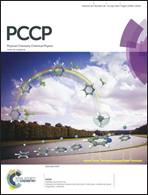Aqueous solutions of tetraalkylammonium halides: ion hydration, dynamics and ion–ion interactions in light of steric effects†
Abstract
Molecular simulations have allowed us to probe the atomic details of aqueous solutions of tetramethylammonium (TMA) and tetrabutylammonium (TBA) bromide, across a wide range of concentrations (0.5 to 3–4 molal). We highlight the space-filling (TMA+) versus penetrable (TBA+) nature of these polyatomic cations and its consequence for ion hydration, ion dynamics and ion–ion interactions. A well-established hydration is seen for both TMA+ and TBA+ throughout the concentration range studied. A clear penetration of water molecules, as well as counterions, between the hydrocarbon arms of TBA+, which remain in an extended configuration, is seen. Global rotation of individual TBA+ points towards isolated rather than aggregated ions (from dilute up to 1 m concentration). Only for highly concentrated solutions, in which inter-penetration of adjacent TBA+s cannot be avoided, does the rotational time increase dramatically. From both structural and dynamic data we conclude that there is absence of hydrophobicity-driven cation–cation aggregation in both TMABr and TBABr solutions studied. The link between these real systems and the theoretical predictions for spherical hydrophobic solutes of varying size does not seem straightforward.


 Please wait while we load your content...
Please wait while we load your content...